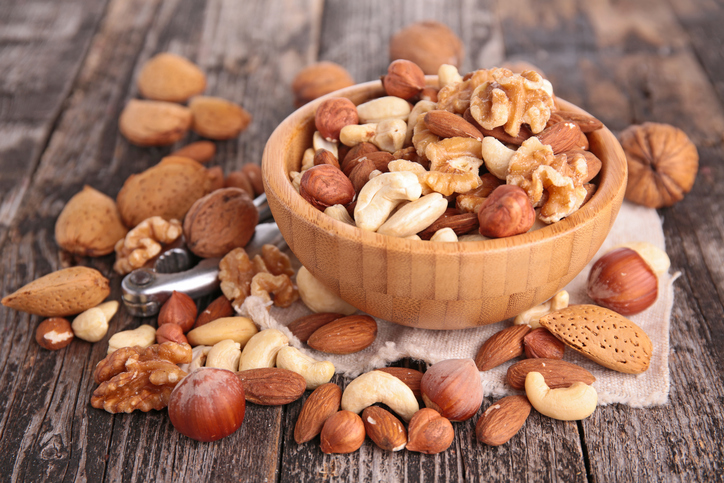
You know what? You should go nuts! No, not that kind of nuts, but actually go and grab a handful of nuts right now. Why? Because they are probably one of the most underrated snacks in America.
Not only do they provide a host of nutrients but they are delicious and a versatile addition to any diet.
The lowest-calorie nuts at 160 per ounce are almonds (23 nuts; 6 grams protein, 14 grams fat); cashews (16 to 18 nuts; 5 grams protein, 13 grams fat); and pistachios (49 nuts; 6 grams protein, 13 grams fat). Avoid nuts packaged or roasted in oil; instead, eat them raw or dry roasted, says Caplan. (Roasted nuts may have been heated in hydrogenated or omega-6 unhealthy fats, or to high temperatures that can destroy their nutrients.)
Peanuts are high in folate—a mineral essential for brain development that may protect against cognitive decline. (It also makes peanuts a great choice for vegetarians, who can come up short on folate, and pregnant women, who need folate to protect their unborn babies from birth defects, says Caplan.) Like most other nuts, peanuts are also full of brain-boosting healthy fats and vitamin E, as well. One ounce of peanuts (about 28 unshelled nuts) contains about 170 calories, 7 grams protein, and 14 grams fat.
Here are 5 reasons nuts add up in the nutrition department.
1. They keep you full. According to a 2008 review of weight and nuts, there is little weight change with including nuts in one’s diet even though they are calorically dense. Scientists believe this has to do with the satiety (filling) value of nuts, as they contain, protein, fiber, and fat. There are even some studies that show that weight loss diets that include nuts have better results and compliance than those that don’t.
So, if you are avoiding nuts in favor of your waistline, don’t!
2. They are good for your heart. Nuts contain the amino acid arginine, which is involved in a process that allows blood vessels to dilate and blood to flow freely. A review in the American College of Nutrition discovered...
... that nut consumers had lower risk factors for hypertension and HDL (good cholesterol) and tree nut consumers had a lower prevalence of abdominal obesity, hypertension, low HDL (good cholesterol), and high fasting glucose.
Which nuts are the healthiest for the heart? In 2003 the FDA approved qualified healthy claim for nuts and cardiovascular disease. The FDA approved peanuts and tree nuts such as almonds, hazelnuts, pecans, some pine nuts, pistachios, and walnuts. Yet they left out Brazil nuts, macadamia nuts, and cashew nuts due to their fat content. But even these nuts can fit into to a healthy diet and are likely to provide some benefits.
3. They contain healthy fats. Most nuts are around 80% fat, but they contain mostly healthy fats from mono and polyunsaturated fats. Adding nuts and nut butter to sandwiches and using them as dips are great ways to balance out the diet with healthier fats that are oh, so satisfying. Watch out for nut butters that contain partially hydrogenated oils (aka trans fat).
4. They boost daily nutrition. Nuts aren’t just good for your heart, they add key nutrients to the diet. While each nut has its unique nutrition profile, most contain vitamin E, magnesium, selenium, folate, fiber, and copper. According to a 2012 study in Nutrition Research, kids and adults who ate at least 1/4 ounce of nuts per day had better nutrient intake than those who didn’t.
5. They improve the taste and texture of food. Whether it’s adding nut butter as a dip for fruits, putting it on sandwiches, or adding nuts to cereal and yogurt, nuts make food taste better. How much is enough? A handful a day is what most experts recommend (1 ounce). Other ideas including making your own trail mix with dried fruit and high-fiber cereal, adding nuts to salads and stir fries, or simply grabbing a handful when afternoon hunger creeps up on you.








